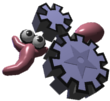Hi All,
I just wanted to share some techniques that have been pretty reliable for
getting foodfinders. The gist of my approach involves starting with a
pretty massively connected neural network with all weights set to zero, do a
neuralweight change only run, select for distance in a world with a bunch of
food. Since this connectionist approach really jacks up the brainsizes, I
call it "The big brain technique".
Here's the longer version.
Creature design:
Start with a creature that has what seem to you to be an approriate amount
of muscles and sensors (there better be one or more smell sensors!). One or
more sticks should have high ingestion. Add three or more interneurons (the
"hidden layer"). Make every muscle receive inputs from every neuron in the
hiddenlayer. Have every neuron in the hidden layer receive inputs from every
muscle, every sensor, and maybe even every other interneuron. Have all
weights set to zero.
Simulation parameters:
You will be doing a neuralnetwork only run which means crossovers=0 and
Morphology mutation intensity=0. Additionally, all neuronnet mutation
probabilities will be set to zero except for "change neuron input weight"
which should be 1.
Set world size to 50, activate teleport, autofeeding=4, ballenergy=1000.
Select for distance (distance=1, all else = 0). Raise water to 1 or 2 if you
like, but most of my foodfinders so far have been land critters.
I think that you will be pleasantly surprised at how soon you will get
creatures with decent velocities . (Central pattern generators will evolve
from these initial conditions pretty rapidly.) That should happen within the
first 10 or 20 million steps. in about one or two hundred million steps your
creatures should should be pretty reliable foodfinders meaning that they are
able to double or triple their lifespans.
Below is one of my sample creatures, "Tripod". (Tripod has both feedforward
and feedback connections between every neuron in the hidden layer and every
neuron in the sensor and motor layers.) Check him out in a world like the
one described above. He has a velocity of only 0.0131976 but acheives
distances over 400 by finding that food and increasing lifespan.
I'll be sharing more foodfinders soon.
Have fun evolving,
Cheers,
Pete Mandik
Pete Mandik's "Tripod":
(RRMMMIIIX[|1:2.602,2:0,8:0.671,9:0,15:-2.347,16:2.663][2:0,4:-1.861,5:0,9:-
29.633,11:-17.987,12:2.009,16:-0.796,18:3.807,19:0,-1:-1.166,3:-748.579,6:0,
10:-2.380,13:1.669,17:0][1:0,3:0,4:0,8:0.788,10:-2.862,11:0,15:1.872,17:0,18
:0,-2:0,2:0,5:0,9:0.510,12:0,16:2.349][G:1.442,-2:-2.341,-1:0,5:-2.190,6:-2.
308,12:0,13:1.693]MMMX[|-3:0,-2:0.589,4:0,5:0,11:2.426,12:0][S:0,-4:-1.500,-
3:-1.269,3:-1.633,4:-2.054,10:0,11:2.366][T:1.459,-5:1.232,-4:1.371,2:3.104,
3:-2.571,9:0,10:2.881],RRMMMX[|-6:-266.762,-5:-4.896,1:-2.808,2:-0.957,8:-45
5.355,9:-1.248][-5:-904.673,-3:-1.437,-2:-2.924,2:0,4:846.870,5:1.872,9:2.18
5,11:2.127,12:0.758,-8:0,-4:2.682,-1:-307.614,3:1.528,6:-2.674,10:1.107][-6:
-0.686,-4:-402.307,-3:-4.531,1:-2.860,3:-675.837,4:-2.460,8:0,10:144.875,11:
-2.298,-9:0,-5:0,-2:-1.684,2:4.243,5:-1.067,9:-0.945][G:2.426,-9:2.942,-8:-2
.012,-2:-2.261,-1:2.881,5:0.921,6:1.263]MMMX[|-10:-2.253,-9:4.580,-3:1.527,-
2:2.338,4:0,5:31.889][S:-4.613,-11:-3.403,-10:0,-4:0,-3:-1.945,3:0,4:1.942][
T:0,-12:-1.003,-11:-0.908,-5:0,-4:0,2:-1.739,3:0],RRMMMX[|-13:2.477,-12:-1.1
40,-6:445.660,-5:0,1:0,2:0][-12:-2.066,-10:-1.932,-9:-0.612,-5:-1.035,-3:1.1
06,-2:-0.900,2:1.916,4:-2.199,5:32.987,-15:-0.489,-11:1.114,-8:1.196,-4:271.
945,-1:1.213,3:-0.590][-13:4.297,-11:0,-10:2.090,-6:-0.416,-4:-2.183,-3:2.10
8,1:-778.579,3:1.809,4:0,-16:-2.815,-12:2.437,-9:3.254,-5:4.770,-2:-919.185,
2:-2.012][G:2.997,-16:0,-15:0,-9:1.419,-8:-3.013,-2:851.565,-1:1.326]MMMX[|-
17:-4.641,-16:0.690,-10:0,-9:3.453,-3:0.815,-2:0][S:0,-18:0.771,-17:-0.979,-
11:745.774,-10:835.833,-4:-0.952,-3:0.348][T:4.428,-19:0.700,-18:-0.572,-12:
0.445,-11:2.070,-5:-2.848,-4:0.897])

